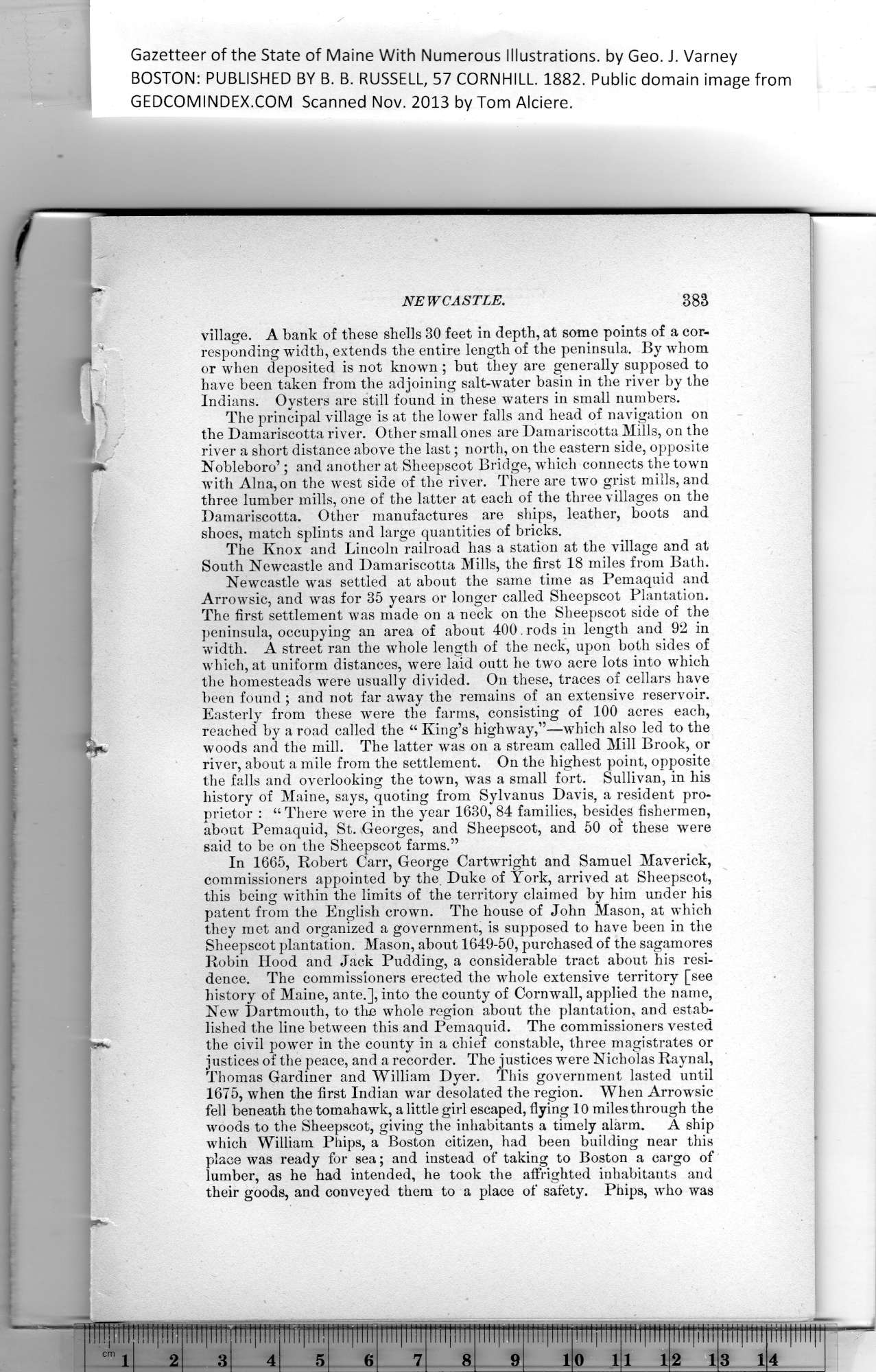|
Gazetteer of the State of Maine With Numerous Illustrations, by Geo. J. Varney
BOSTON: PUBLISHED BY B. B. RUSSELL, 57 CORNHILL. 1882. Public domain image from
NEWCASTLE. 883
village. A bank of these shells 30 feet in depth, at some points of a cor-
responding width, extends the entire length of the peninsula. By whom
or when deposited is not known ; but they are generally supposed to
have been taken from the adjoining salt-water basin in the river by the
Indians. Oysters are still found in these waters in small numbers.
The principal village is at the lower falls and head of navigation on
the Damariscotta river. Other small ones are Damariscotta Mills, on the
river a short distance above the last; north, on the eastern side, opposite
Pfc Nobleboro’; and another at Sheepscot Bridge, which connects the town
with Aina, on the west side of the river. There are two grist mills, and
three lumber mills, one of the latter at each of the three villages on the
Damariscotta. Other manufactures are ships, leather, boots and
shoes, match splints and large quantities of bricks.
The Knox and Lincoln railroad has a station at the village and at
South Newcastle and Damariscotta Mills, the first 18 miles from Bath.
Newcastle was settled at about the same time as Pemaquid and
Arrowsic, and was for 35 years or longer called Sheepscot Plantation.
The first settlement was made on a neck on the Sheepscot side of the
peninsula, occupying an area of about 400. rods in length and 92 in
width. A street ran the whole length of the neck, upon both sides of
which, at uniform distances, were laid outt he two acre lots into which
tbe homesteads were usually divided. On these, traces of cellars have
been found ; and not far away the remains of an extensive reservoir.
Easterly from these were the farms, consisting of 100 acres each,
reached by a road called the “ King’s highway,”—which also led to the
woods and the mill. The latter was on a stream called Mill Brook, or
river, about a mile from the settlement. On the highest point, opposite
the falls and overlooking the town, was a small fort. Sullivan, in his
history of Maine, says, quoting from Sylvanus Davis, a resident pro-
prietor : “ There were in the year 1630, 84 families, besides fishermen,
about Pemaquid, St. Georges, and Sheepscot, and 50 of these were
said to be on the Sheepscot farms.”
In 1665, Robert Carr, George Cartwright and Samuel Maverick,
commissioners appointed by the Duke of York, arrived at Sheepscot,
this being within the limits of the territory claimed by him under his
patent from the English crown. The house of John Mason, at which
they met and organized a government, is supposed to have been in the
Sheepscot plantation. Mason, about 1649-50, purchased of the sagamores
Robin Hood and Jack Pudding, a considerable tract about his resi-
dence. The commissioners erected the whole extensive territory [see
history of Maine, ante.], into the county of Cornwall, applied the name,
New Dartmouth, to the whole region about the plantation, and estab-
lished the line between this and Pemaquid. The commissioners vested
w*- the civil power in the county in a chief constable, three magistrates or
justices of the peace, and a recorder. The justices were Nicholas Raynal,
Thomas Gardiner and William Dyer. This government lasted until
1675, when the first Indian war desolated the region. When Arrowsic
fell beneath the tomahawk, a little girl escaped, flying 10 miles through the
j woods to the Sheepscot, giving the inhabitants a timely alarm. A ship
) which William Phips, a Boston citizen, had been building near this
place was ready for sea; and instead of taking to Boston a cargo of
I lumber, as he had intended, he took the affrighted inhabitants and
* their goods, and conveyed them to a place of safety. Phips, who was
PREVIOUS PAGE ... NEXT PAGE
This page was written in HTML using a program written in Python 3.2
|
